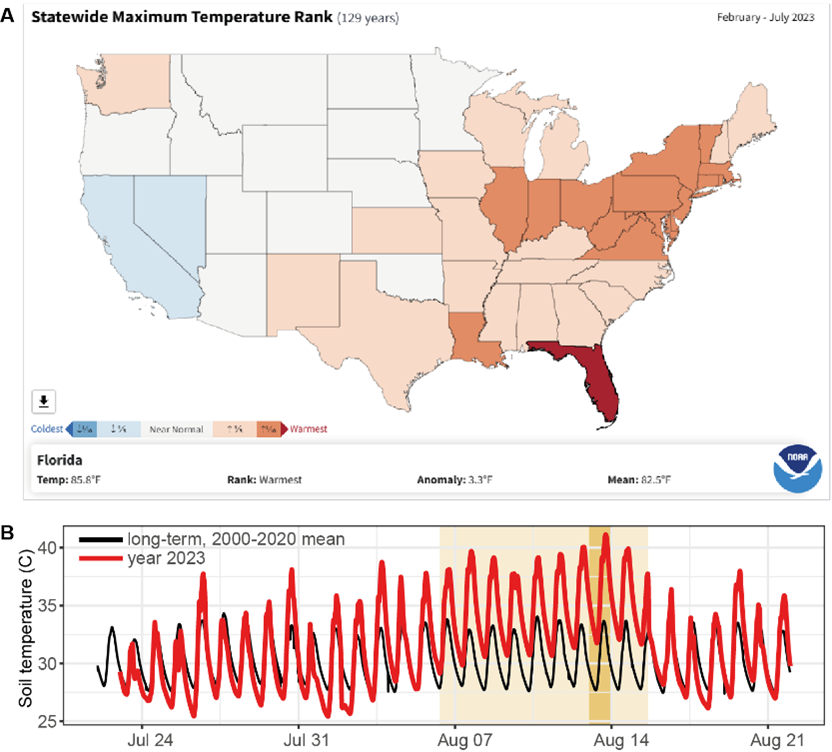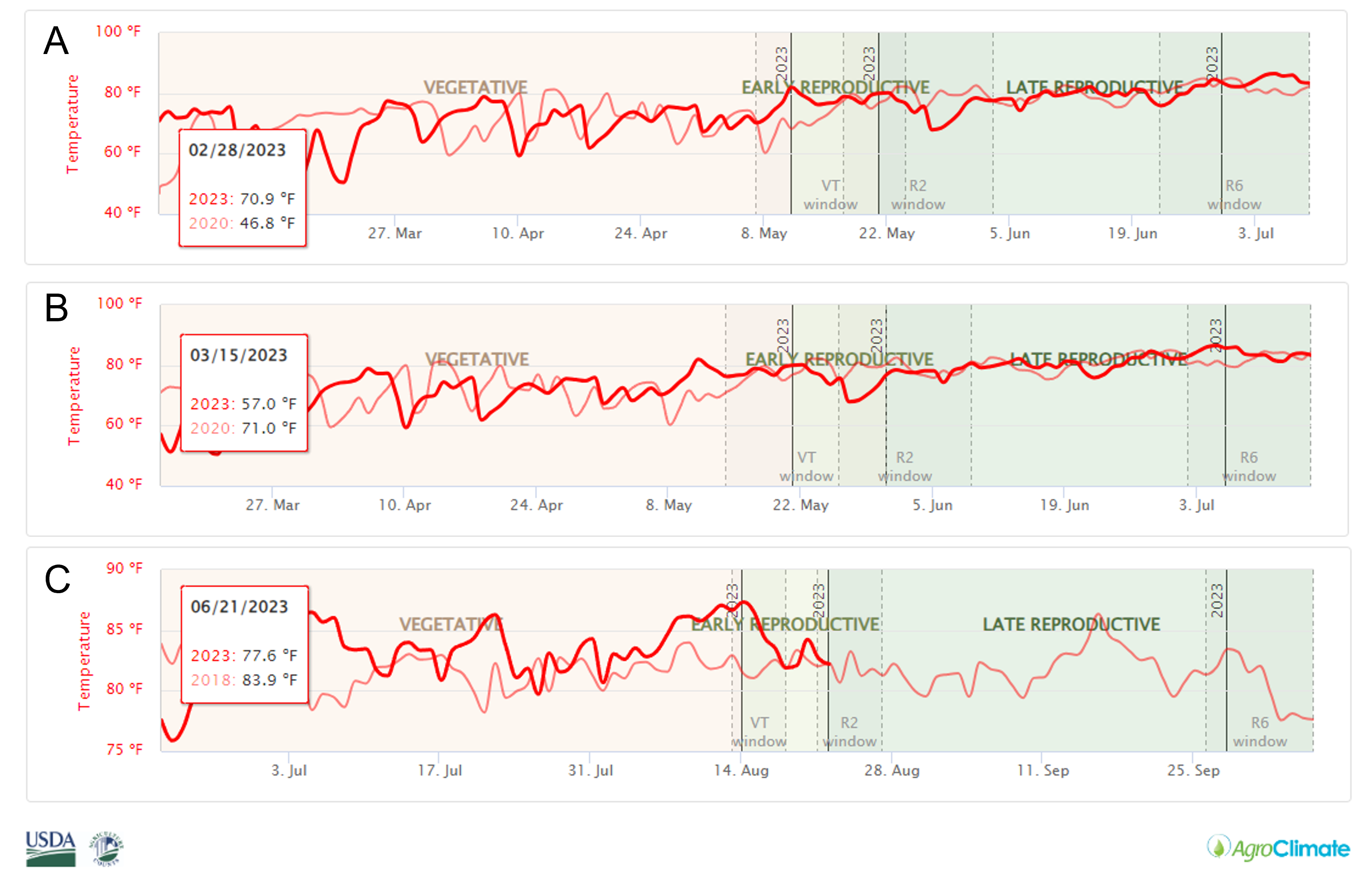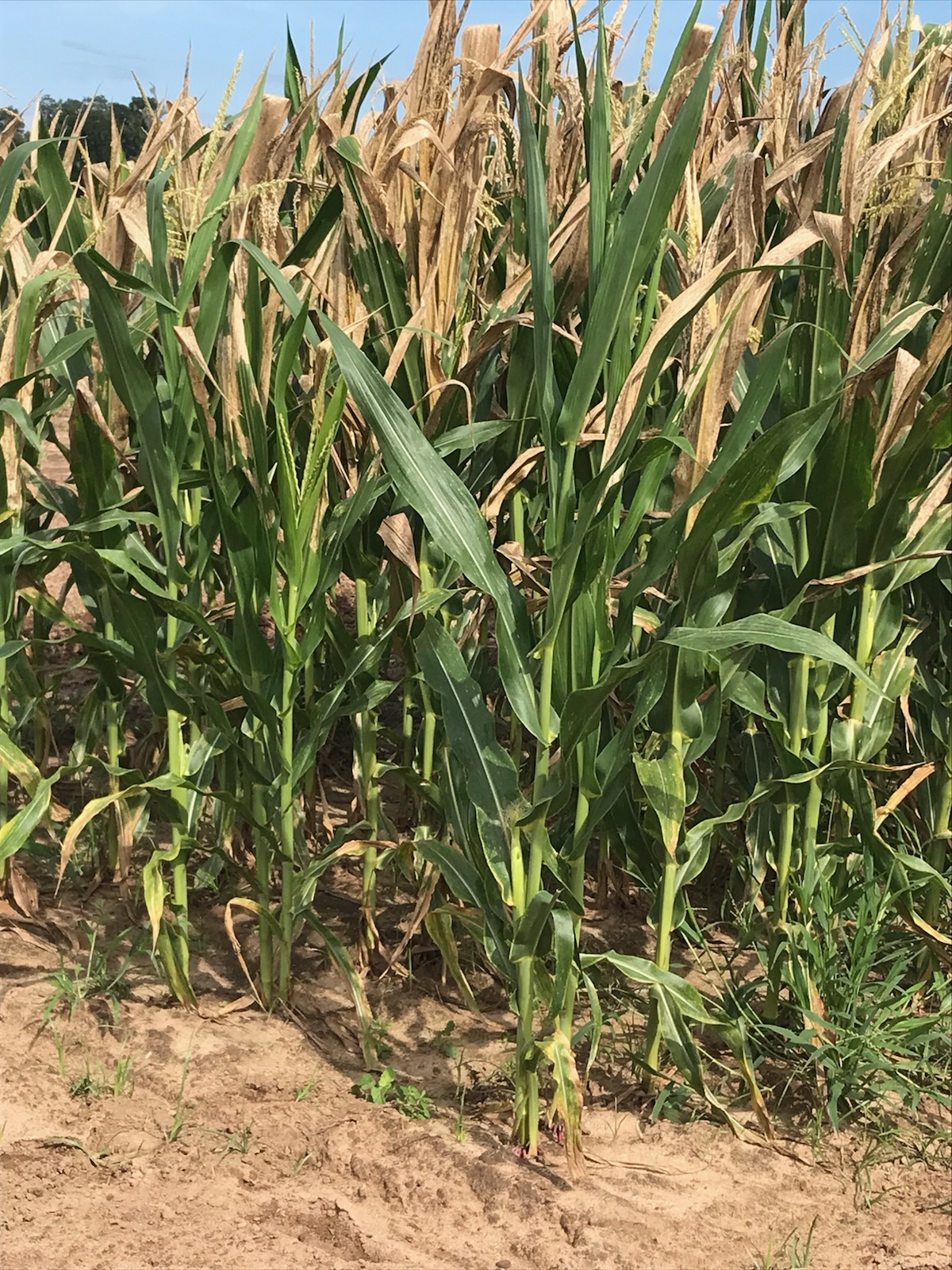William Hammond, UF/IFAS Plant Physiologist, Marcelo Wallau, UF/IFAS Forage Extension Specialist, Clyde Fraise, UF/IFAS Agrometeorologist, and Gerard Sapes, UF/IFAS Plant Physiologist
Florida is going through one of the hottest summers on record. Between February 1st 2023 and July 31st, 2023, the state of Florida is the only state in the US to have set an all-time record for both daytime and nighttime maximum temperatures, meaning that these six months were the warmest in the 129-year record of observations (Figure 1a, source: NOAA). On top of that, a heatwave in mid-August (peaking on August 13th) led to damage in a range of forage crops across the state of Florida (Figure 1b). Even for well-irrigated crops, the August heatwave was damaging (Figure 2).

Figure 1: The state of Florida had its warmest February – July 2023 (6-month period) in the 129-year instrumental record, by far the largest state-wide anomaly in the continental United States (Panel A; data from NOAA). Panel B shows soil temperatures at the University of Florida’s Plant Science Research and Education Unit in Citra, Florida where a 10-day heatwave first damaged silage corn. Soil temperatures in 2023 (heatwave atop record-hot growing season) are shown in red, while the long-term (2002-2022 average) for the same period is shown in black. Soil temperature reached a maximum of 41.2 °C (106 °F) on August 13th (golden ribbon), an anomaly of 8 ° C (15 °F) from the long-term trend.
–
More than rolling leaves, what we observed on some late-planted corn silage crop was the scalding (sunscald) of the top, immature leaves; resembling herbicide or fertilizer injury (Figure 2). The damage, however, was caused by extreme heat, and could be observed across the planted area. The interesting part is that, despite growing under a very warm growing season, corn was still not able to acclimate to heat and sustain production after the heat wave. Heat stress is well documented in corn and has been haunting producers and markets. Depending on the phenological (developmental) stage of the crop, heat stress can impact both production (tonnage) and quality of corn silage by lowering starch accumulation and pollination, and increasing aborted kernels and fiber concentration. Temperatures above 86 °F will start reducing photosynthesis, which can stop all together at 115 °F. In corn, if a heat wave hits during the silking phase, with temperatures above 100 °F, the results will be pollen failure and aborted kernels.
–
Another effect that we have seen is the fast maturation of corn crops, because of the rapid accumulation of degree days. For our spring planted variety trials, where we had 42 hybrids ranging in relative maturity from 108 to 130 days. All materials were harvested between 90 and 105 days of planting. Thus, on average, our spring trials matured between 20 and 30% earlier than expected. The results from our hybrid trials can be found at the Silage Hybrid Decision Tool on our website (this year’s data will soon be available).
Considering all this and looking ahead, more questions come to mind.
Will this be a recurring problem in Florida? What impacts will it have for Florida’s agricultural sector? How can we mitigate the effects of extreme weather events on our crops?
Variety selection and planting dates are the first strategies to mitigate climate impacts. Early planting (March) will help avoid high temperatures, especially during tasseling and silking (Figure 3). However, early planting can also increase the risk of injury from late frosts (such as this past April). Choosing varieties that are more adapted to hot and humid conditions, favoring tropical genetics – especially for late plantings – will be essential as well. Irrigation can help reduce heat damage, but the amount of water needed might not be sustainable or available.

Figure 3. Simulation of a 114 RM corn, in Citra, FL, planted Feb 28 (A), March 15 (B) and June 21 (C), using AgroClimate Phenology and Weather Tracker. Bold lines represent 2023 average daily temperature. Thin lines are a comparison with 2020 (for reference). Note that the high accumulation of heat units also anticipates the onset of reproductive phase on the summer planting. The probability of high heat during the early reproductive phase, where there is the highest potential for damage when corn is planted in the summer. On the other hand, risk of temperatures below 32 F increase with early planting dates.
–
Platforms such as the AgroClimate website offer excellent tools to help manage climate risk in agriculture and understand what is happening during the season. The AgroClimate website provides interactive tools and climate information to improve resource use efficiency and to reduce crop production risk associated with climate variability and change. With predictions such as those shown in Figure 3, producers can make informed decisions about when to plant crops, taking into account factors like frost dates and temperature trends, manage irrigation and select varieties most likely to succeed. The AgroClimate website has a wide variety of other tools available to help producers make informed decisions. For more information on such tools, consult with your local extension agent or reach out to us at forages@ifas.ufl.edu.
- Cow Talks: Special Guests Discuss the Impact of H5N1 Avian Influenza on Agriculture - April 25, 2025
- Why is this weed here? Weed Management in Pasture Systems - February 28, 2025
- What to Look for When Selecting Hybrid Corn Varieties for Silage? - January 31, 2025

